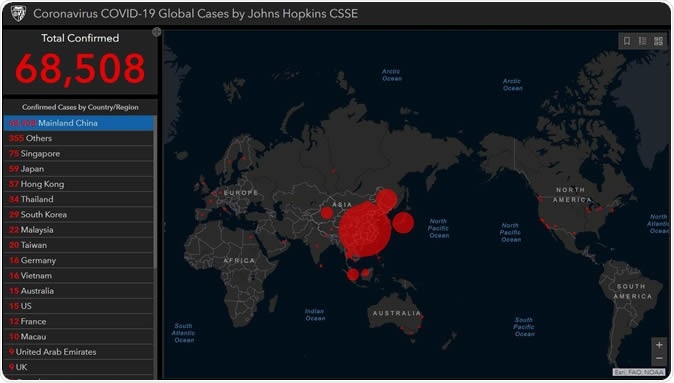The coronavirus disease (COVID-19) outbreak, which started in Wuhan, in Hubei province in China, now has nearly 1,700 deaths and more than 69,000 infections. The majority of the infections and deaths are in mainland China but has started to spread across 25 countries. Are these numbers alarming?
In Hubei province, the epicenter of the deadly virus, 116 more people died on Feb. 13, following the deadliest day in the area since the start of the outbreak on Feb. 12, with a staggering 272 deaths recorded. The total death toll is now 1,596 in the province alone, and 1,667 in mainland China.
An additional 4,823 cases were confirmed in Hubei, bringing the total to 56,249. Overall, the number of infections has reached 69,288 worldwide.

Coronavirus COVID-19 Global Cases by Johns Hopkins CSSE
The sudden spike of the cases is attributed to the new way of calculating the outbreak toll, including people who were clinically diagnosed with the infection based on their signs and symptoms and radiologic results. Being tested for the virus is hard in China since access to diagnostic and treatment facilities has become limited, with many healthcare workers becoming ill with the virus, too.
According to the World Health Organization (WHO), if the clinically diagnosed cases were not included in the tally, the new infections as of Feb. 13 are 1,820, bringing the total to 46,550. China, however, reported 13,332 clinically confirmed cases, those who manifested the symptoms and those who died but did not have the confirmatory test.
“We understand that most of these cases relate to a period going back over days and weeks and are retrospectively reported as cases, sometimes back to the beginning of the outbreak itself. So, this increase that you’ve all seen in the last 24 hours is largely down to a change in how cases are being diagnosed and reported,” Dr. Michael Ryan, Executive Director, WHO Health Emergencies Program, said.
“We’ve seen this spike in the number of cases reported in China, but this does not represent a significant change in the trajectory of the outbreak,” he added.
Slowing down or just starting?
Has China reached the peak of the outbreak? In most outbreaks in the past, just like the SARS outbreak and the Ebola outbreak in Africa, the trend went from a rapid increase in cases, and after the peak, it will slowly level off until no more infections were reported.
In China, the sudden spike in cases may hint the leveling off of the outbreak, but the WHO says it’s too early to tell. Some health experts also pointed out that even if China has reached the peak of infections and will plateau, some countries have just started reporting new cases.
Two dozen countries have reported confirmed cases of the coronavirus disease, including those on board the cruise ship off the coast of Japan. Japan reported the most number with 355 on the cruise ship and 59 on land, followed by Singapore with 75 confirmed cases. In Singapore, the largest bank, DBS, has evacuated 300 employees when one had tested positive with the virus. All the employees worked on the same floor as the patient.
Thailand reports 34 confirmed cases, followed by South Korea with 29 cases, Malaysia with 22, Taiwan with 20, Germany with 16, Vietnam with 16, Australia with 15, the U.S. with 15, France with 11, U.K. with 9, United Arab Emirates (UAE) with 9, and Canada with 7 cases. The other countries had three or fewer cases include India, Philippines, Italy, Russia, Spain, Cambodia, Finland, Nepal, Sri Lanka, Sweden, and Belgium.
How to sport coronavirus disease?
For those who had been to China, especially Wuhan, those who have traveled to countries and cities with a high number of infections, and those who have been in close contact with confirmed cases, it’s important to spot the symptoms early to receive appropriate treatment and to prevent the spread of the virus.
The common signs and symptoms include fever, followed by a dry cough. After about a week, shortness of breath will manifest, prompting hospitalization in most cases. In severe cases, the infection may lead to pneumonia, severe acute respiratory syndrome, kidney failure, and even death.